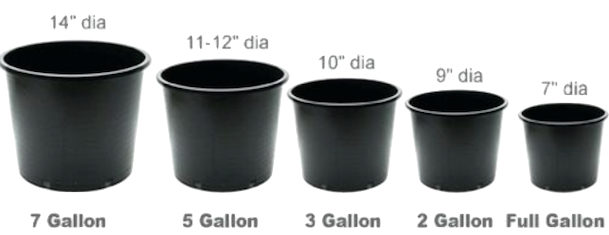Plants are often sold and priced by the size of the container in which they're growing, and those containers tell you a fair bit about how mature the plant is.
Very young plants are available to nurseries (and sometimes retail consumers) in small or large flats consisting of many small cells. Then, as the plants grow, nursery staff transplant them into ever-larger containers, so they have room to safely spread out and mature.
Because of that, there are an extremely large variety of container sizes out there. What do the sizes mean? And which should you get?
Annuals and tender perennials (perennials in warmer climes, but are killed by cold weather in our climate) don't get very old, so they are typically sold in retail stores in flats of 4-72 plugs or small (4" pots, quarts, etc.) or large (8", 10", 1 or 2 gallon) pots. The former are cost-effective for covering large spaces, and the larger pots are a little farther along, to help you make a bigger impression right away (perhaps, in a container on your front porch).
The pot sizes of perennials -- which can be expected to live for multiple years -- vary much more. Young perennials are sold in affordable small (for instance, 4.5") containers and occasionally flats of young plants for cost-effectively filling large areas. Retail nurseries often carry larger, more mature perennials -- especially shrubs and trees -- in much larger-sized containers for their customers who want to make an immediate impact in their landscape. The larger the container, the older and more-established the plants are: #1 containers often contain plants which are 12-18 months old, #2/3 containers about 2-3 years old (depending on the growth rate of that specific plant), and #5/#7 3-5 years old. The nursery has to nurture the plant for a lot longer, so plants in bigger containers are generally more expensive!
The sizes of larger plant containers are "standardized," but still (in our opinion) a bit confusing. #1 Containers (a staple of the nursery industry) are occasionally called "Gallon Containers," but would hold around 3 quarts if you filled them completely with water (You usually can't -- they have holes in the bottom so the plants don't drown). The larger the container number, the larger the pot.
Here are some sizes which are common in the nursery business:

| Size | Volume | Diameter | Typical Age of Plant | |||
|---|---|---|---|---|---|---|
| #1 Container | 3 Quarts | 7" | About 1 Year | |||
| 8" Pot | 1.2 Gallons | 8" | 1-2 Years | |||
| #2 Container | 1.7 Gallons | 9" | 2-3 Years | |||
| #3 Container | 2.5 Gallons | 10" | 2-3 Years | |||
| #5 Container | 3.8 Gallons | 11-12" | 3-5 Years | |||
| 12" Pot | 4 Gallons | 12" | 3-5 Years | |||
| #7 Container | 6.1 Gallons | 14" | 3-5 Years |
The standard list of pot sizes (each number a bit bigger than the last) continues through about #25, but the #1-5 containers are most common in retail nurseries since beyond that point you may need help to move them around!
Small shrubs and trees (and some pretty large ones) are often sold in containers for convenience sake, but really big shrubs and trees are often sold balled and burlapped (B&B). B&B trees are often described either by their height (often measured in feet), or by the diameter of the trunk (measured in inches) at chest hight. Where most people can handle a #5 container by themselves, larger plants and their root balls can get very heavy (hundreds of pounds) and large and usally require some special equipment to move about!
On the far end of the spectrum are flats of young plants which can help you cost-effectively fill large areas. The length and width of flats doesn't change size as much so much as the plants in them do. The plants in a 72 flat tend to be younger and smaller than the 24 flat are smaller than in a 10 flat, etc. The difference between 10/12 flats mostly comes down to which trays the nursery bought a lot of. 1801 trays are 6x3 (hence the 18) attached ~3"x~3"x3" sections. Sometimes the flat size/shape is chosen to fit the way a particular plant grows -- whether they tend to root broad or deep. What size is best for you may depend on your use for them (if you need to cover a lot of area, more may be better) and level of patience (do you want them to look full sooner). It's pretty easy to tell the difference between the sizes now, but in a few months what you've planted from any of the flats will likely look pretty similar!
Only you can really answer this question!
If you are a patient person -- or have a limited budget -- you may enjoy buying your plants small (and cheap) and watching them grow. Flats of annuals or perennials or large numbers of smaller plants are great for covering large areas quickly, and watching them grow and mature is a kind of magic! Smaller plants are easier to get in the ground (small holes) in our clay soil, they'll adjust to your soil more quickly, and planting them closer together can help keep weeds from establishing. On the other hand, there's more work involved, the root systems won't be as well-established (so you'll initially have to water them more frequently), and you'll have to wait a bit longer to see the "finished product."
Many of us, though, have a spot in our yard which we want to make look good now! If this is your goal, you should focus on the more mature plants in larger container sizes (which you'll see more of at high-end nurseries), which will make a bigger impact in your landscape right away.